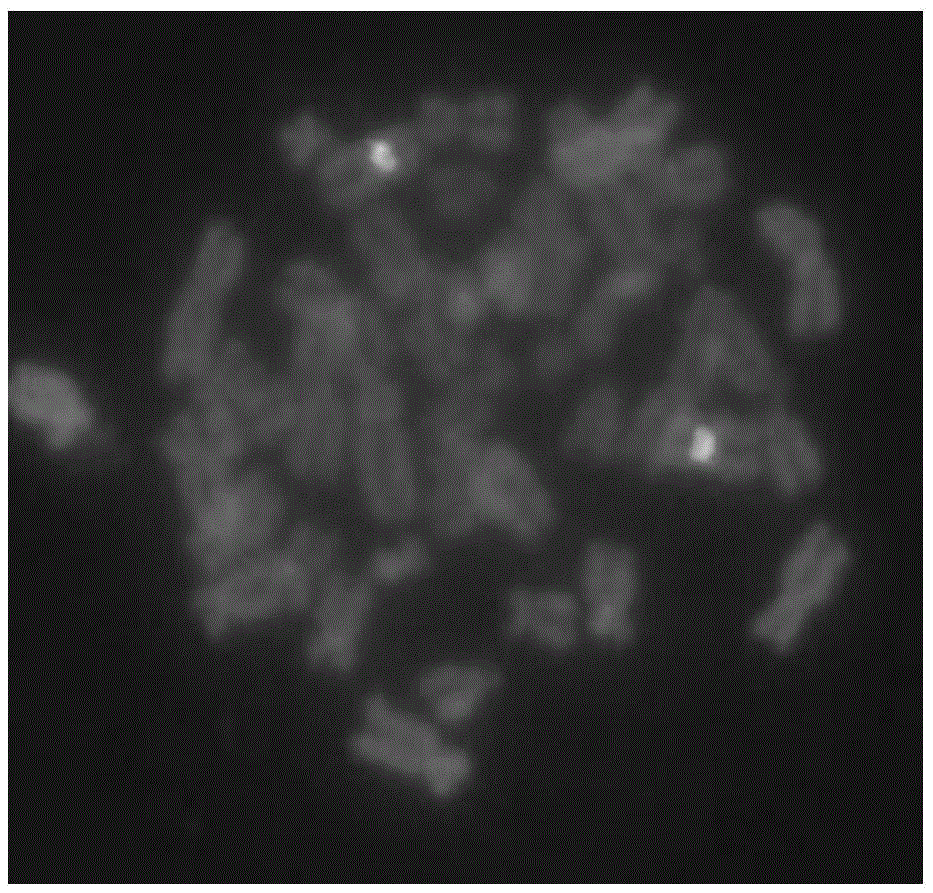EGFR gene detection probe, preparation method thereof and reagent kit
A gene detection and kit technology, which is applied in the field of EGFR gene detection probes and its preparation, can solve the problems of high detection kits and lack of specificity, and achieve the goals of improving survival rate, accurate signal counting, and adjuvant treatment plan selection Effect
- Summary
- Abstract
- Description
- Claims
- Application Information
AI Technical Summary
Problems solved by technology
Method used
Image
Examples
Embodiment 1
[0033] The preparation of embodiment 1 EGFR gene detection probe
[0034] The preparation method of the EGFR detection probe described in this implementation comprises the following steps:
[0035] Select the clones containing the target gene EGFR and the sequences at both ends, such as figure 1 shown.
[0036] GSPEGFR includes two groups, respectively including probe group 1: the first probe, the second probe, the third probe and the fourth probe; probe group 2: the first probe, the second probe and the third probe Needles, as shown in the table below, were purchased from Invitrogen RP11BAC and CTDBAC clone banks. The following two groups of detection probes were prepared respectively.
[0037] EGFRchr7:55,086,725-55,275,031,188,307bp
[0038] First group
[0039] Probe set 1
BAC
Insert segment start and end position
first probe
RP11-748O6
chr7:54,711,888-54,884,289,172,402bp
second probe
RP11-164G7
chr7:54,818,676-54,995,52...
Embodiment 2
[0053] Embodiment 2: Preparation method of EGFR gene detection kit
[0054] The EGFR gene detection kit includes two components of EGFR hybridization solution and DAPI counterstaining agent, wherein the EGFR hybridization solution contains the GSPEGFR gene probe described in Example 1 (respectively two groups of detection probes, corresponding to two kits) , CSP7 probe (identification probe for chromosome 7), buffer components for hybridization environment (promoting hybridization), COT Human DNA for blocking repetitive sequences, etc. DAPI counterstaining agent is mainly used for cell counterstaining after hybridization, in which DAPI will bind to DNA, making the nucleus show blue fluorescence, and the counterstaining agent containing p-phenylenediamine can keep the fluorescence stable.
[0055] The specific formula is as follows:
[0056] (1) Preparation of hybridization solution
[0057]
[0058] (2) DAPI counterstain preparation
[0059] Dissolve 10 mg of p-phenylene...
Embodiment 3
[0062] Embodiment 3: the detection method of EGFR gene detection kit
[0063] 1. Slide pretreatment
[0064] 1.1 Place the slides in a 65±5°C incubator and bake overnight;
[0065] 1.2 Take out the slide and put it in xylene to dewax at room temperature for 15 minutes;
[0066] 1.3 Take out the slide, and put it into another vat of xylene to continue dewaxing at room temperature for 15 minutes;
[0067] 1.4 Take out the slide, and put it in absolute ethanol at room temperature for 10 minutes to remove residual xylene;
[0068] 1.5 Take out the slide, and put it into 100%, 90%, 70% graded ethanol for rehydration at room temperature for 3 minutes each;
[0069] 1.6 Take out the slide, put it in purified water and wash it at room temperature for 3 minutes, and absorb excess water with a lint-free paper towel;
[0070] 1.7 Take out the slides, put them into purified water and boil them at 100±5°C for 25 minutes (place the slides horizontally in the container with the sample si...
PUM
 Login to View More
Login to View More Abstract
Description
Claims
Application Information
 Login to View More
Login to View More - R&D
- Intellectual Property
- Life Sciences
- Materials
- Tech Scout
- Unparalleled Data Quality
- Higher Quality Content
- 60% Fewer Hallucinations
Browse by: Latest US Patents, China's latest patents, Technical Efficacy Thesaurus, Application Domain, Technology Topic, Popular Technical Reports.
© 2025 PatSnap. All rights reserved.Legal|Privacy policy|Modern Slavery Act Transparency Statement|Sitemap|About US| Contact US: help@patsnap.com



